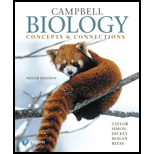
Concept explainers
SCIENTIFIC THINKING By measuring the fossil remains of Homo floresiensis, scientists have estimated its weight to be around 32.5 kg and its brain volume to be roughly 420 cm3. Plot these values on the graph in Figure 19.13A. Which hominin has the most similar relationship of brain volume to body mass? Does this information support the hypothesis that H. floresiensis is a dwarf form of H. erectus, or an alternative hypothesis? Explain.
Trending nowThis is a popular solution!
Learn your wayIncludes step-by-step video

Chapter 19 Solutions
Campbell Biology: Concepts & Connections (9th Edition)
Additional Science Textbook Solutions
Biology: Life on Earth with Physiology (11th Edition)
Human Physiology: An Integrated Approach (8th Edition)
Anatomy & Physiology (6th Edition)
Anatomy & Physiology
Laboratory Experiments in Microbiology (12th Edition) (What's New in Microbiology)
Brock Biology of Microorganisms (15th Edition)
- What do the marks found on the Bodo cranium indicate? A. The removal of flesh from the skull by tool-using hominins, either as a ritual or as some form of cannibalism. B. The earliest example of carnivore tooth marks on a hominin fossil. C. A pathology associated with poor diet, which may have contributed to this individual’s death. D. The fabrication of the fossil as a hoax, demonstrating that science is ultimately self-correcting.arrow_forwardBased on height calculations of Homo erectus fossils, biological anthropologists estimate that their average height was A. Similar to that of Australopithecines. B. Short, with most being approximately three feet. C. More than 70% taller than Homo habilis. D. Tall, within the range of modern humans.arrow_forwardAdaptations are physical or behavioral traits that help an organism survive in its environment. What are some of the adaptations in the evolution of hominins that allowed for the evolution of the genus Homo to evolve (eventually) into modern humans (Homo sapiens)? (Note: you don’t have to explain why these adaptations allowed the genus to evolve, just list some of the adaptations.)arrow_forward
- Which of the following is one of the main tendencies observed in early hominins, such as australopithecines? A. Decrease in the number of incisors B. Reduced canine size C. Increased facial prognathism D. Increased diastemaarrow_forwardIn the paper “Four Legs good, Two Legs Fortuitous...” what were the selective pressures that drove early hominin evolution? How was Australopithecus physically different from modern day Homo sapiens? How did these traits suit each species to their environment? Describe the role of bipedalism in Homo sapiens evolution. Approximately how early did bipedalism occur?arrow_forwardWhich of the following is considered to be the “first man” in the evolution of humans? a. Australopithecus africanus b. Ardipithecus ramidus c. Australopithecus anamensis d. Orrorin tugenensis Which group of hominins does the first australopith to be described belong to? a. Australopithecus anamensis b. Australopithecus sediba c. Australopithecus afarensis d. Australopithecus africanusarrow_forward
- Why are the Dmanisi Homo erectus fossils significant? A. They demonstrate that H. erectus independently evolved in Western Asia and Africa. B. They show that H. erectus evolved in Western Asia and then migrated to Africa. C. They demonstrate that H. erectus migrated to Western Asia shortly after evolving in Africa. D. They show that H. erectus migrated from Europe into Western Asia.arrow_forwardFossilized remains of prehistoric mastodons show anatomical similarities to modern-day elephants. These similarities provided the first evidence that mastodons were related to modern-day elephants. Which of the following is the BEST additional evidence that mastodons were related to elephants? A. Mastodons walked on four legs like modern-day elephants. B. Mastodon tissues contained proteins with similar amino acid sequences compared to modern-day elephants. C. Mastodon fossils were found in the same area where modern-day elephants live. D. Mastodons ate a diet similar to that of modern-day elephants.arrow_forwardThe following species is not a hominin: a) Pan troglodytes b) Paranthropus robust is c) Australopithecus africanus d) Homo erectus e) Homo sapiensarrow_forward
- Which of the following is responsible for the early predominant image of Neanderthals as brutish cavemen? a). They had small brain cases with stocky bodies and were always recovered from cave sites b). The fossil evidence reveals that they had little cognitive capacity and had a hunched over posture c). An early fossil find of an Individual suffering from arthritis was assembled and taken as the type specimen foer all Neanderthals, mistakenly giving the idea that Neanderthals were an ape-like, hunched-over species.d). None of the above are truearrow_forwardWhat do the Homo erectus fossils from Sangiran, Java, demonstrate? A. H. erectus spread to Eastern Asia after spreading to Europe. B. H. erectus fossils are older in Asia than in Africa. C. H. erectus inhabited parts of Eastern Asia prior to living in Western Asia. D. H. erectus spread rapidly eastward from Western Asia.arrow_forwardHomo neanderthalensis, Australopithecus afarensis, Homo habilis, and Homo erectus. According to fossil records and discoveries, how do these human species vary?arrow_forward
 Human Biology (MindTap Course List)BiologyISBN:9781305112100Author:Cecie Starr, Beverly McMillanPublisher:Cengage Learning
Human Biology (MindTap Course List)BiologyISBN:9781305112100Author:Cecie Starr, Beverly McMillanPublisher:Cengage Learning
